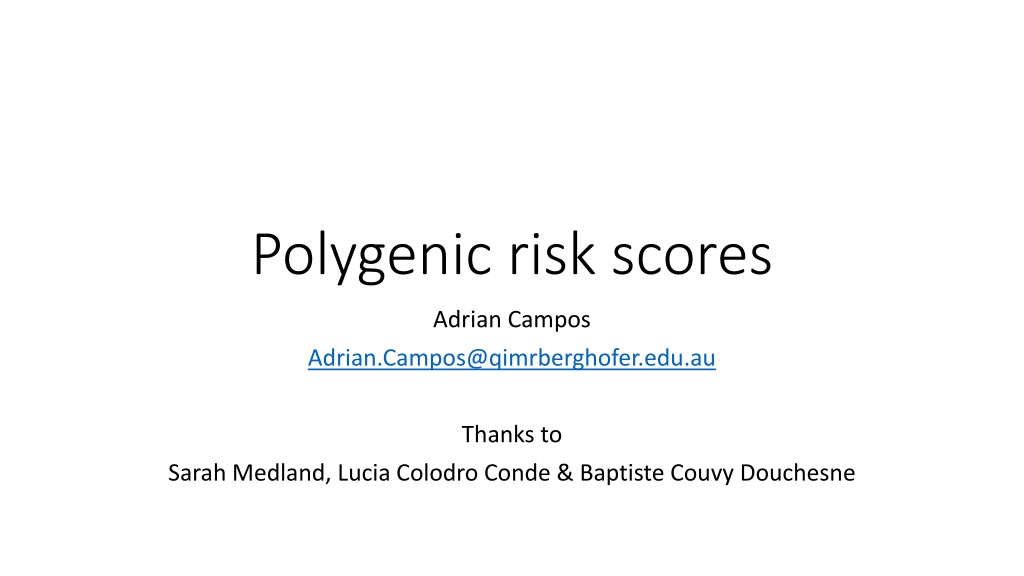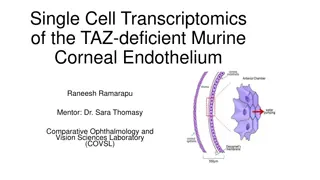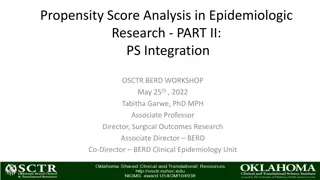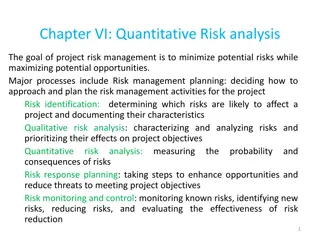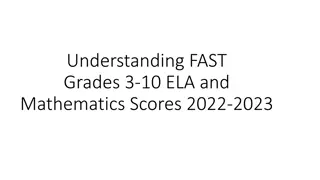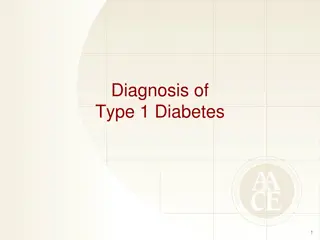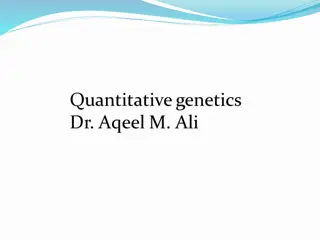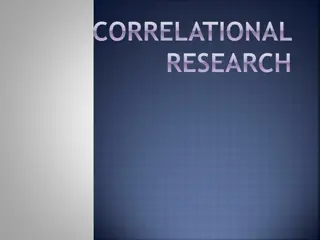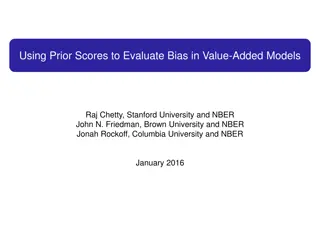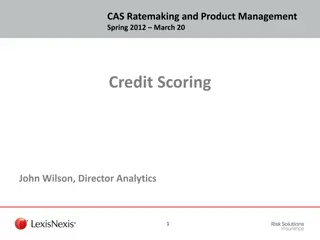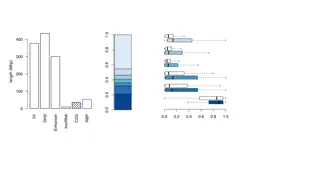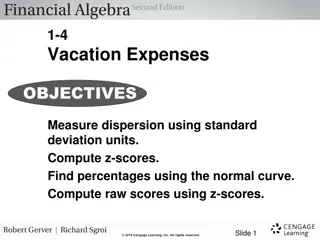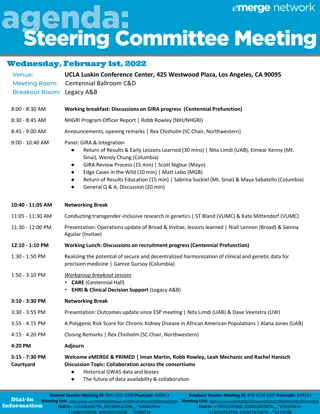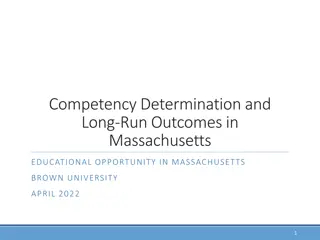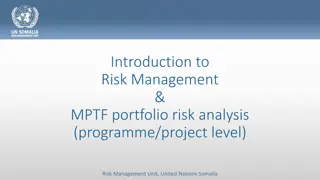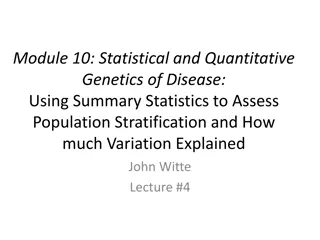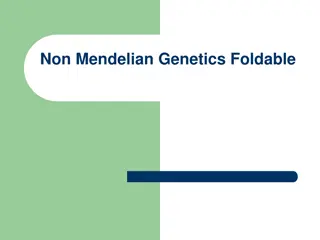Polygenic risk scores
Polygenic risk scores (PRS) utilize multiple genetic variants to estimate overall trait scores, improving prediction accuracy for complex traits. This presentation discusses GWAS, allele effect sizes, variant selection, LD considerations, and diverse PRS applications.
Download Presentation

Please find below an Image/Link to download the presentation.
The content on the website is provided AS IS for your information and personal use only. It may not be sold, licensed, or shared on other websites without obtaining consent from the author. Download presentation by click this link. If you encounter any issues during the download, it is possible that the publisher has removed the file from their server.
E N D
Presentation Transcript
Polygenic risk scores Adrian Campos Adrian.Campos@qimrberghofer.edu.au Thanks to Sarah Medland, Lucia Colodro Conde & Baptiste Couvy Douchesne
Layout Introduction recapitulating GWAS and allele effect sizes PRS overview graphical summary of what a PRS is Which variants to include and accounting for LD Traditional clumping and thresholding Applications for PRS Other methods for PRS Summary
Layout Introduction recapitulating GWAS and allele effect sizes PRS overview graphical summary of what a PRS is Which variants to include and accounting for LD Traditional clumping and thresholding Applications for PRS Other methods for PRS Summary
A regression would show an average increase of 2cm per copy of the G allele. So the effect size of this variant would be approximately 2.
In a new sample we would expect AG individuals to be on average 2cm taller than AA and 2cm shorter than GG
Complex traits are highly polygenic! From above we can see there are many more genetic variants that contribute to the phenotype Common variants typically have a small effect size (our example is an exaggeration for a common variant!). This would cause single-loci based prediction useless We can combine the information we gain from several genetic variants to estimate an overall score and gain a better estimate of the trait. This is essentially what a PRS does
Layout Introduction recapitulating GWAS and allele effect sizes PRS overview graphical summary of what a PRS is Which variants to include and accounting for LD Traditional clumping and thresholding Applications for PRS Other methods for PRS Summary
PRS overview Effect size of 2cm per G allele +4 +4 +2 +0 +0 +2 +0 +2 +2
Effect size of -1 per T allele -1 +0 -1 +0 +0 -2 -2 -1 -2 +4 +4 +2 +0 +0 +2 +0 +2 +2
Effect size of +0.5 per G allele +0.5+0.5 +1 +0.5 -0.5 +0 +0.5 +0 +0 -1 +0 -1 +0 +0 -2 -2 -1 -2 +4 +4 +2 +0 +0 +2 +0 +2 +2
Note on ambiguous variants + A/C rsxxy A MAF C This variant is not ambiguous rsxxy T MAF G - T/G + A/T rsxxx A MAF T This variant is ambiguous rsxxx T 1-MAF A - T/A Note that one can usually solve ambiguity with information on allele frequency, but it gets tricky if its close to 0.5 (it is easy to drop them; as non-ambiguous SNPs will still tag variance thanks to LD)
Repeat including the other variants and sum across all loci Will give you an estimate of their polygenic risk for the trait of interest Polygenic risk score Weighted sum of alleles which quantify the effect of several genetic variants on an individual s phenotype.
Repeat including the other variants and sum across all loci Caution! The sample for which PRS will be calculated should be independent from that of the discovery GWAS. Sample overlap will bias your results. PRS GWAS
Layout Introduction recapitulating GWAS and allele effect sizes PRS overview graphical summary of what a PRS is Which variants to include and accounting for LD Traditional clumping and thresholding Applications for PRS Other methods for PRS Summary
Repeat including the other variants the other variants and sum across all loci Things to consider: We know many GWAS are underpowered (there s many more true associations than those discovered) Linkage-disequilibrium creates a correlation structure within the variants. Its important to use independent SNPs (or account for their correlation somehow)
Clumping Select all SNPs that are significant at a certain p-value threshold (p1 parameter, set to 1 for traditional approach) Form clumps of SNPs within a certain distance (kb param) to the index SNP if they are in LD with the index SNP (r2 param)
Clumping and thresholding approach The variants left are approximately independent, but there is still the question of how significant the association needs to be for inclusion in the PRS calculation
Clumping and thresholding approach Solution: Calculate many PRS including more and more variants (reducing the p-value threshold used to filter them) Example 8 p-value thresholds: Number of independent variants included in PRS calculation p<5e-8 p<1e-5 p<0.001 p<0.01 p<0.05 p<0.1 p<0.5 p<1 723 2310 10473 30201 73120 110168 285410 393492
PRS trait association Think about your sample: > Is it a family based sample? ! Adjust for relatedness e.g. LMM > Is it homogeneous in terms of ancestry? -Always a good idea to adjust for genetic PCs >Does it match the GWAS ancestry? Think about your trait: > Is it continuous linear regression > Binary logistic or probit regression > Ordinal cumulative linked mixed models > Always remember potential confounders of the trait and of the discovery GWAS
Power of PRS analysis increases with GWAS sample size PGC-MDD2: N=163k max variance explained =0.46%, p= 5.01e-08 PGC-MDD1: N=18k max variance explained = 0.08%, p=0.018 Colodro-Conde L, Couvy-Duchesne B, et al, (2017) Molecular Psychiatry
C+T also allows us to explore the pattern of variance explained Variance explained = partial R2 for quantitative traits. Different ways of estimating it for binary traits
Layout Introduction recapitulating GWAS and allele effect sizes PRS overview graphical summary of what a PRS is Which variants to include and accounting for LD Traditional clumping and thresholding Applications for PRS Other methods for PRS Summary
Test for GWAS association and quantify variance explained Risk stratification (i.e. identifying people to later test for specific disease) Aid in clinical diagnosis Test for genetic overlap between traits (e.g. does a Depression PRS predict cardiovascular disease?) Trait imputation when not measured (obviously imperfect and dependent on heritability) Personalized treatment (GWAS on treatment response are gaining power) Any hypothesis where you rely on a risk or liability (e.g. GxE interactions)
Layout Introduction recapitulating GWAS and allele effect sizes PRS overview graphical summary of what a PRS is Which variants to include and accounting for LD Traditional clumping and thresholding Applications for PRS Other methods for PRS Summary
Beyond clumping and thresholding C+T (your options): PLINK PRSice2 bigsnpR (R library) Other types of PRS: LDpred2 Implemented in bigsnpR SBayesR Implemented in GCTB Lassosum (and lassosum2) Implemented in bigsnpR PRS-CS JAMPred
Commonality across these approaches If our sample size and computational power was big enough we could run a multiple linear regression model, and use the joint effect sizes (also called sometimes conditional) for PRS Because we can t, what we do is to run m regressions (one for each SNP) thus obtaining their marginal effect sizes. The lack of adjustment for correlation is obvious from the Manhattan plot skyscrapers To solve this problem we need to find a method to approximate the multiple linear regression results based on the GWAS summary statistics
Beyond clumping and thresholding Approaches for fancier PRS: LDpred2 Implemented in bigsnpR o Gibbs sampler to estimate joint SNP effects (replacing clumping) SBayesR Implemented in GCTB o Estimates joint SNP effects using Bayesian multiple regression Lassosum (and lassosum2) Implemented in bigsnpR o Penalized (LASSO) regression (complementary to LDpred2 for MHC) PRS-CS o Joint SNP effects using Bayesian regression with continuous shrinkage priors JAMPred o Two step Bayesian regression framework
SBayesR Combines a likelihood connecting the joint effects with GWAS summary statistics and a finite mixture of normal distribution priors for marker effects. Models the SNP effect sizes as a mixture of normal distributions with mean zero and different variances. Typically uses four normal distributions with mean zero and variances = Requires GWAS summary statistics with FREQ, BETA, SE and N; and an LD reference matrix Then performs a Markov chain Monte Carlo Gibbs sampling for the model parameters:
SBayesR Combines a likelihood connecting the joint effects with GWAS summary statistics and a finite mixture of normal distribution priors for marker effects. Models the SNP effect sizes as a mixture of normal distributions with mean zero and different variances. Requires GWAS summary statistics with FREQ, BETA, SE and N; and an LD reference matrix Lloyd-Jones, Jian Zeng, et al (2019)
LDpred2 Addressed instability issues in LDpred providing a more stable workflow. Models long range LD such as that found near the HLA region. Estimated effect sizes from a Gibbs sampler (also MCMC) It also adds two new models to the traditional LDpred: Also derives an expectation of joint effects given marginal effects and correlation between SNPs 1. Estimate p and h2 from the model instead of testing several values and LD-score regression (LDpred2-auto). Thus no intermediate validation dataset is needed to tune these parameters. Assumes: 2. LDpred2-sparse allows for effect sizes to be exactly 0 (similar to the first mixture component of SBayesR) With p= proportion of causal variants and h2 estimated using Ldscore regression. Grid for p:
LDpred2 Addressed instability issues in LDpred providing a more stable workflow. Models long range LD such as that found near the HLA region. Also derives an expectation of joint effects given marginal effects and correlation between SNPs Assumes: With p= proportion of causal variants and h2 estimated using Ldscore regression. Grid for p: Bioinformatics, Volume 36, Issue 22-23, 1 December 2020, Pages 5424 5431
Beyond clumping and thresholding These approaches usually perform better than (or at least as well as) C+T When they don t, maybe raise an eyebrow (sometimes the models don t converge and they might fail silently) Still an area of active research and a clear battle between complexity and power vs scalability and ease of use There s many publications comparing them, read them and pick the one that better fits your needs
Layout Introduction recapitulating GWAS and allele effect sizes PRS overview graphical summary of what a PRS is Which variants to include and accounting for LD Traditional clumping and thresholding Applications for PRS Other methods for PRS Summary
PRS- Weighted sum of alleles. A tool for estimating the genetic liability or risk to traits Essential: QC GWAS data (discovery) QC Genotype data (target) SNP identifiers need to be matched Independent discovery and target samples Consider statistical power When using PRS: Beware of related individuals in the sample Adjust for population stratification Ancestry consideration (portability issues) Be wary of jumping too fast to conclusions consider potential biases in the discovery GWAS and the target sample.
References for PRS Wray NR, Goddard, ME, Visscher PM. Prediction of individual genetic risk to disease from genome-wide association studies. Genome Research. 2007; 7(10):1520-28. Evans DM, Visscher PM., Wray NR. Harnessing the information contained within genome-wide association studies to improve individual prediction of complex disease risk. Human Molecular Genetics. 2009; 18(18): 3525-3531. International Schizophrenia Consortium, Purcell SM, Wray NR, Stone JL, Visscher PM, O'Donovan MC, Sullivan PF, Sklar P . Common polygenic variation contributes to risk of schizophrenia and bipolar disorder. Nature. 2009; 460(7256):748-52 Evans DM, Brion MJ, Paternoster L, Kemp JP, McMahon G, Munaf M, Whitfield JB, Medland SE, Montgomery GW; GIANT Consortium; CRP Consortium; TAG Consortium, Timpson NJ, St Pourcain B, Lawlor DA, Martin NG, Dehghan A, Hirschhorn J, Smith GD. Mining the human phenome using allelic scores that index biological intermediates. PLoS Genet. 2013,9(10):e1003919. Dudbridge F. Power and predictive accuracy of polygenic risk scores. PLoS Genet. 2013 Mar;9(3):e1003348. Epub 2013 Mar 21. Erratum in: PLoS Genet. 2013;9(4). (Important Important discussion discussion of of power power) Wray NR, Lee SH, Mehta D, Vinkhuyzen AA, Dudbridge F, Middeldorp CM. Research review: Polygenic methods and their application to psychiatric traits. J Child Psychol Psychiatry. 2014;55(10):1068-87. (Very Very good good concrete concrete description description of of the the traditional traditional methods methods). Wray NR, Yang J, Hayes BJ, Price AL, Goddard ME, Visscher PM. Pitfalls of predicting complex traits from SNPs. Nat Rev Genet. 2013;14(7):507-15. (Very the the complexities complexities of of interpretation interpretation). Very good good discussion discussion of of Witte JS, Visscher PM, Wray NR. The contribution of genetic variants to disease depends on the ruler. Nat Rev Genet. 2014;15(11):765-76. (Important understanding understanding of of the the effects effects of of ascertainment ascertainment on on PRS PRS work work). Important in in the the Shah S, Bonder MJ, Marioni RE, Zhu Z, McRae AF, Zhernakova A, Harris SE, Liewald D, Henders AK, Mendelson MM, Liu C, Joehanes R, Liang L; BIOS Consortium, Levy D, Martin NG, Starr JM, Wijmenga C, Wray NR, Yang J, Montgomery GW, Franke L, Deary IJ, Visscher PM. Improving Phenotypic Prediction by Combining Genetic and Epigenetic Associations. Am J Hum Genet. 2015; 97(1):75-85. (Important Important for for the the conceptualization conceptualization of of polygenicity polygenicity)
